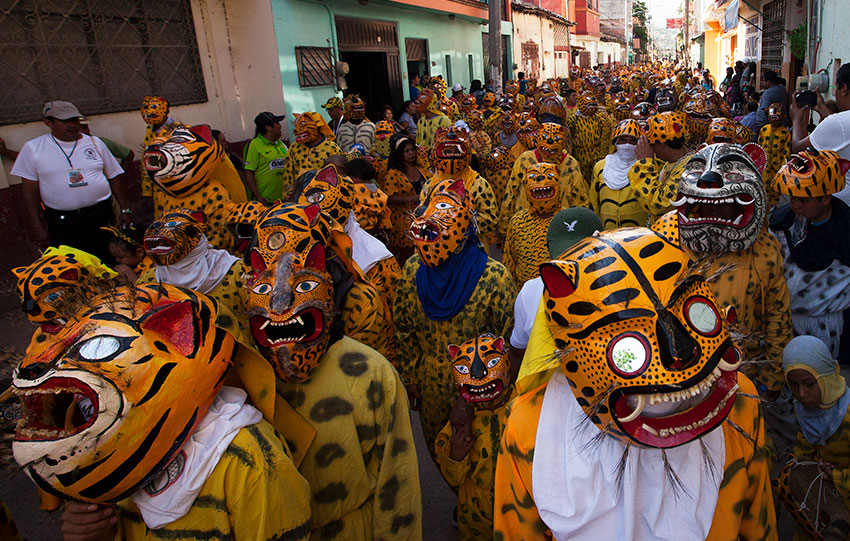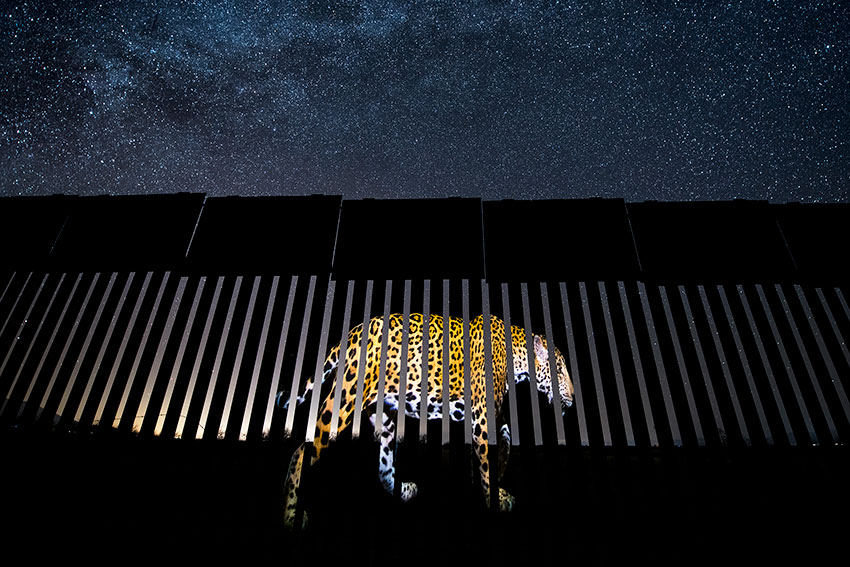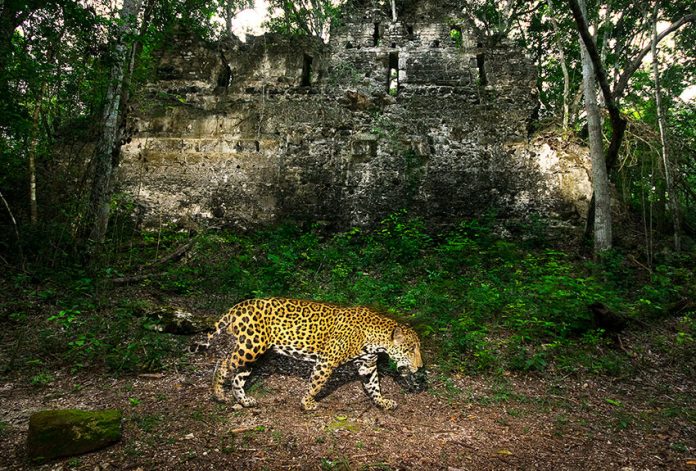For several months, photographer Alejandro Prieto sought to capture images of a jaguar in the wild and had set up camera traps across western and southern Mexico in hopes of getting a picture of one of the elusive big cats.
When he finally got that first image, it showed only the tail of a jaguar, disappearing into the background. But it was a good start.
“For me, it was a huge success,” Prieto reflected in a phone interview. “After that photograph, I started to have more images. I started to be more effective, more successful.”
Prieto ultimately took around 100 images of jaguars in a photographic journey called Jaguar Story. Documenting the endangered big cats in remote areas of such states as Nayarit and Campeche, he also sought to evoke the impact of the jaguar on indigenous and Hispanic culture in Mexico.
“I think I achieved what I wanted,” he said, adding that while it took “more [time] than I was expecting, it was definitely worth it.”
Even though he finished the project several years ago, he remains interested in the jaguar, which he calls “an iconic species.”
A separate photo, “Another Barred Migrant,” shows a projection of a jaguar onto an image of the border wall between Mexico and the US. Created for his Border Wall Project, the photo earned Prieto a wildlife photographer of the year award for 2019 from the Natural History Museum of London — his second straight win in what he calls “the Oscars of wildlife photography.”
More recently, another photo from the project “Roadrunner Approaching the Border Wall” earned a second-place award in the World Press Photo 2020 contest.
A lifelong animal enthusiast, the 43-year-old Guadalajara native has captured images of such diverse fauna as the axolotl, flamingo and sea lion during his career. For Jaguar Story, he turned his lens to a notoriously camera-shy subject.
“I talked to local people who lived in a jungle all their lives,” Prieto recalled. “They had never seen a jaguar their entire life. We would see tracks, marks, and know they were there, but the cats are just too shy. They’re very smart. Before you see them, they see you. That’s why it’s difficult to get to see one.”
The project required a significant degree of preparation and patience. Prieto trekked up mountains and through jungles to set up his camera traps, aided by local residents and researchers.

“Many places were really very remote,” Prieto said. “We would walk for hours.”
The hours-long walks, the mountain climbs and the jungle excursions eventually yielded that first photograph about five months in. Then more images started flowing as Prieto began to learn more about his subject — such as in Calakmul, home to an archaeological site and the largest number of jaguars in all of Mexico.
“We would start to see signs of jaguars,” Prieto said, such as their tracks, and their urine on trees. “I heard them twice. It happens in their mating season, a really strong noise when the female communicates with the male. It’s a sound you can [hear] from the long distance of a mountain. Hearing this sound is something I will never forget.”
He’s also amazed by how adaptable the jaguar is, able to survive in a variety of terrain, from the desert to the jungle to the mountains. His favorite camera-trapping locations include the Sierra de Vallejo in Nayarit as well as Calakmul.
“This animal needs a lot of terrain to survive,” Prieto explained. “It does not stay in one place. It’s constantly moving.”
Humans have negatively impacted the jaguar’s journey, Prieto said, listing such factors as habitat loss and ranchers who defend their livestock from predators. The number of jaguars has dipped from a “very large” number 30 to 40 years ago to only 3,500 today, he said.
“[People are] taking the environment of a territorial animal that needs a big territory, that is losing the jungles. [People are] taking their habitat, which is still the main problem, not just for the jaguar but most of the wild animals.” And, he said, there have been “decades, as well, of illegal hunting.”
He also noted that if a jaguar kills a rancher’s livestock, the rancher might poison the carcass, which “could kill not just one, but many other predators that feed at the same carcass. [The rancher does] not really care about this.”
Asked whether the jaguar poses a danger for humans, Prieto said, “I think there is no record here in Mexico that a jaguar attacked one single person … I think Brazil has had a couple of [recorded instances], some specific situations.”
He added, “Many, many people think jaguars are dangerous. I have talked to people [who have] killed jaguars, communities [who have] killed them because they thought jaguars were going to attack them. It’s absolutely false. They try to run away from people. It’s something that we [Prieto and the western Mexico-based nonprofit Alianza de Jaguar] try to tell people.”
Historically, jaguars and humans seem to have had a closer understanding of each other.

“Jaguars are very important not only for pre-Hispanic culture and for Mayans, but very important for some other cultures as well,” Prieto said.
One of his favorite photos is of a jaguar crossing in front of an archaeological site.
“It’s an image I like very much,” Prieto said, adding that it seeks to convey the idea that “the jaguar is an ancient animal, passing in front of a site of ancient culture.”
Some ancient ties have parallels today, such as in jaguar-connected festivals across Mexico. Prieto visited and photographed one — La Tigrada in the town of Chilapa de Álvarez, Guerrero. La Tigrada takes place every August 15, the same day as the Feast of the Assumption. As a Guerrero state website explains, the relatively young festival is a fusion of religion and culture, honoring the Virgin Mary and the Mesoamerican Mother Earth and Tepēyōllōtl — the latter an Aztec mountain god who was turned into a jaguar.
The municipality of Chilapa was described as “one of the most lawless areas of Mexico” by the Los Angeles Times this year. The festival seems like a respite: Prieto describes La Tigrada as a memorable event with such activities as a parade, singing and dancing, with participants wearing unique jaguar costumes.
“They do many different activities,” he said. “Everything is related to jaguars. I think they’re invoking the jaguar gods so they can have good crops, a good rainy season. It’s really amazing because every person does their [own] costume and every costume is different.”
Prieto traveled north for his Border Wall Project and a different look at the jaguar — this time at the dwindling numbers in the region and the environmental impact of U.S. President Donald Trump’s wall along the U.S.-Mexico border. According to Prieto, completing the structure will doom the many migratory species native to the area.
“There’s still no wall in the mountains,” Prieto said, referring to the Huachuca Mountains in Arizona and Sonora. “But the intention is to cover them with a wall. Once [they’re] closing off the area with a wall, it will be the end of the jaguar in the U.S. There are only two to three individuals, all males.”
As he explained, jaguars “need to move to survive, they need to move to get water, they need to move to get mates, they need to move to get food, to get the right environment to survive.”
Reflecting on the decline of the local jaguar population, Prieto sought to photograph a jaguar there but could not find one.
“After a certain time, I realized it was going to be impossible,” he said.
As a result, he found an image of a wild jaguar he had previously taken — he said it might be from either Calakmul or San Luis Potosí — and projected it onto a photo of the Mexican side of the wall, near the Huachuca Mountains in Sonora, along the Arizona border. He titled the photo “Another Barred Migrant.”

“I wanted to do it in the same place, in the same area, where jaguars crossed the mountains,” Prieto said. “They would cross the top of the mountains, down the mountains, between states.” He described the photograph as “a way to say, these cats are still here, but they will not be able to be [here] any more if [people] continue to do this.”
The Natural History Museum of London took notice, and last year Prieto was among the winners of the Wildlife Photographer of the Year award, his second straight time receiving the honor.
“It’s something that really gets me proud,” Prieto said. “At the same time, [it’s] like a platform. Your picture can be shown to millions and millions of people around the world. It’s very, very important to me … What I did with the photograph, my main goal, is to focus on conservation.”
Prieto is now working on a new photographic endeavor with a similar goal: The Gardener, a look at the tapir, which he calls the gardener of the jungle.
Comparing the tapir to “a little elephant,” he said that the species is “very, very important for jungles” because, like a gardener, tapirs “take care of the jungle.” Yet, he said, they are in danger of extinction.
It will be similar to the jaguar project, Prieto said. “Of course, it’s a different situation. Different things are happening to [the jaguar]. But the habitat loss is the same.”
Mexico News Daily
